What secrets hide in the mysterious world of Freemasonry? This ancient fraternal group has captured the hearts of people worldwide. With its rich history and diverse members, freemasonry is full of intrigue. The degree system, from Entered Apprentice to Master Mason, is especially mysterious.
We will uncover the history and importance of masonic lodges. We’ll look at freemasonry’s charitable work, rituals, and symbols. This organization is a big part of modern society, helping with disaster relief, education, and medical research.Freemasonry
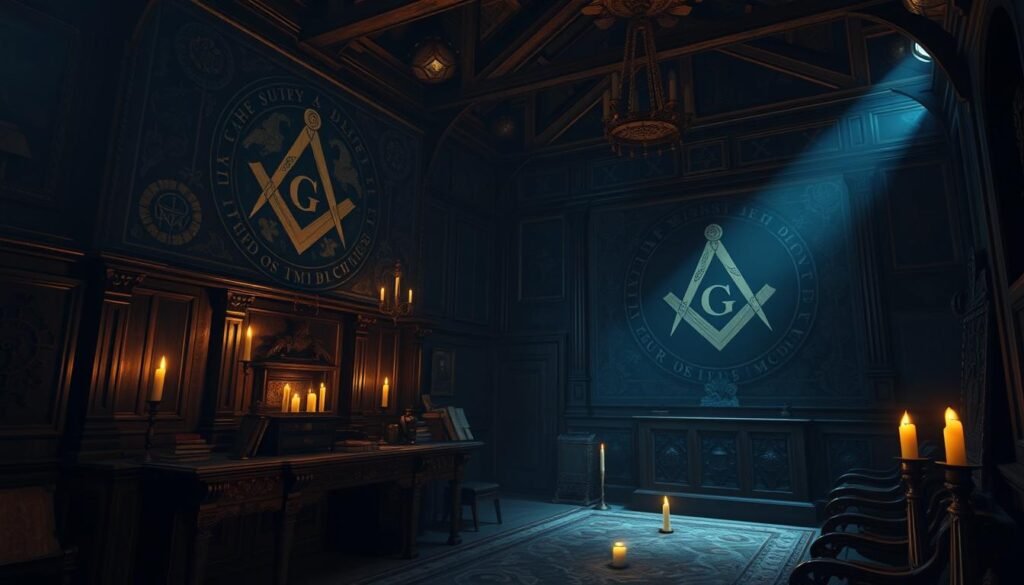
Key Takeaways
- Freemasonry is the oldest fraternal organization in the world, with a diverse membership that includes some of the most influential people in the world.
- The degree system of freemasonry includes common degrees such as Entered Apprentice, Fellowcraft, and Master Mason.
- Freemasonry requires candidates to have a belief in a Supreme Being, be of good moral character, and meet specific age requirements.
- Freemasons are known for their charitable activities at local, national, and international levels, supporting various causes.
- Freemasonry has a rich history, with its roots dating back to the Middle Ages in Europe as a guild of skilled builders.
- Many influential figures throughout history have been Freemasons, including George Washington, Benjamin Franklin, and Winston Churchill.
The Ancient Origins of Freemasonry
Freemasonry’s history is both fascinating and complex. It began with medieval stone mason guilds. The masonic history is filled with stories and legends. The first Grand Lodge in London was formed in 1717, marking a big change.Freemasonry
This event helped shape freemason history and masonic traditions.
The Halliwell Manuscript, from 1390 to 1425, is the oldest known masonic text. It gives us a glimpse into the craft’s early days. As the grand lodge system grew, Freemasonry spread worldwide. Lodges and organizations popped up everywhere.
The masonic history shows the craft’s lasting impact. Its values and principles still inspire Freemasons today.
- The formation of the Premier Grand Lodge of England
- The creation of the first grand assembly of English Masons at York under Athelstan’s son, Edwin
- Ramsay’s 1737 lecture in France, which added the Crusaders to the lineage of Freemasonry
These events have woven a rich tapestry of masonic traditions and freemason history. They have shaped Freemasonry into what it is today.
Understanding Modern Freemasonry
Freemasonry today is alive and full of energy, with roots going back to the 14th century. It’s a place where men from different lives come together. They learn, grow, and help their communities. Freemasonry aims to improve good men into even better ones.
The masonic brotherhood spans the globe, connecting people who share its values. With over six million members, it’s a huge and varied fraternal group. People from all walks of life join, wanting to change the world for the better.
Modern freemasonry focuses on several key areas:
- Community service and charity
- Personal growth and self-improvement
- Inclusivity, welcoming all men, regardless of religion or background
- A rich cultural heritage with unique rituals and symbols
Being part of a modern masonic lodge is rewarding. Members find personal growth, friendship, and ways to help others. Freemasonry offers something for everyone, from history buffs to those who love community service. It’s an organization that truly makes a difference.
The Organizational Structure of Masonic Lodges
The masonic lodge structure is complex and has grown over time. It has a clear hierarchy and leadership that guides Masonic lodges. There are different types of lodges, like Blue Lodges and appendant bodies, each with its own role.
The lodge hierarchy has three main ranks: Entered Apprentice, Fellow Craft, and Master Mason. The highest rank is Master Mason. After reaching this level, members can explore more through organizations like the Scottish Rite or York Rite.
Lodge Hierarchy and Leadership
The Worshipful Master leads the lodge, overseeing its members and activities. They are aided by officers like Senior and Junior Wardens, Treasurer, and Secretary. Together, they ensure the lodge runs smoothly and support its members.
Different Types of Lodges
There are various types of masonic lodges, each with its own purpose. These include:
- Blue Lodges: These are the core of Freemasonry. They welcome new members and teach them Masonic values.
- Appendant bodies: These groups are connected to Freemasonry but not part of the main lodge structure. They offer additional degrees and teachings to Master Masons.
Global Masonic Jurisdictions
Masonic jurisdictions cover the areas where lodges operate. Each is overseen by a Grand Lodge. Examples include the United Grand Lodge of England and the Grand Orient of France.
The masonic lodge structure is intricate and steeped in tradition. Understanding its hierarchy, types of lodges, and jurisdictions helps us appreciate Freemasonry’s principles and its members’ roles.
| Type of Lodge | Purpose | Characteristics |
|---|---|---|
| Blue Lodge | Initiation and foundation in Masonic principles | Basic unit of Freemasonry |
| Appendant body | Supplemental degrees and teachings | Affiliated with Freemasonry, but not part of basic lodge structure |
Core Principles and Values of the Masonic Brotherhood
The Masonic brotherhood is built on key principles and values. These include brotherly love, relief, and truth. These masonic principles and masonic values are the heart of the organization. They guide the actions and decisions of its members.
Some important principles and values are:
- Brotherly love: Freemasons see all humans as one family. They act with respect and support those in need.
- Relief: Masonic relief work is done quietly. It includes giving money, meals, or practical help.
- Truth: Masons value truth highly. They aim to improve themselves, their families, and communities through knowledge and ethics.
These masonic principles and masonic values are key to the Masonic brotherhood. They show in the organization’s focus on education, helping others, and community service. Freemasons try to make the world better and create a brighter future for everyone.
The Masonic brotherhood stands for brotherly love, relief, and truth. They aim to help and support all people. By living these masonic values and masonic principles, Freemasons build a community of support and mutual respect.
| Core Principle | Description |
|---|---|
| Brotherly Love | Emphasizes treating all humans with respect and kindness |
| Relief | Provides help to those in need, often quietly and anonymously |
| Truth | Values honesty, integrity, and ethical behavior |
Masonic Symbols and Their Meanings
Masonic symbols, like the square and compass, are key in Freemasonry. They teach moral and spiritual lessons. The square and compass stand for doing right and staying within moral limits.
Other symbols include the All Seeing Eye, the Anchor, and the Acacia Tree. They mean hope, peace, and lasting life. Architectural symbolism is also big in Freemasonry. Symbols like the Masonic Altar and the Ark of the Covenant show connection with God and keeping sacred texts safe.
The use of sacred geometry in masonic symbols is important. Symbols like the 47th Problem of Euclid show the importance of order and foundation in Freemasonry. Some main masonic symbols are:
- The Square and Compasses
- The All Seeing Eye
- The Anchor and the Ark
- The Acacia Tree
- The Masonic Altar
- The Ark of the Covenant
These symbols, like the square and compass, teach moral and spiritual lessons. They are crucial to the masonic tradition. Understanding these symbols helps us see the values and principles of Freemasonry.
| Symbol | Meaning |
|---|---|
| The Square and Compass | Morality and virtue |
| The All Seeing Eye | God’s omniscience and wisdom |
| The Anchor and the Ark | Hope and peace |
Ritual and Ceremony in Freemasonry
Freemasonry is famous for its masonic rituals and masonic ceremonies. These are key parts of the fraternity’s tradition and practices. The rituals, like initiation ceremonies, teach moral and ethical lessons. They are vital to the Masonic experience.
The masonic rituals are made to share important values. These include brotherly love, relief, and truth. The rituals are serious, aiming to make good men even better. Symbols, allegories, and metaphors add depth and meaning, helping with personal growth.
Some important parts of masonic ceremonies are:
- The use of ritualized scripts and formats to convey important messages and principles
- The importance of secrecy and discretion in maintaining the integrity of the rituals
- The role of initiation ceremonies in welcoming new members into the fraternity
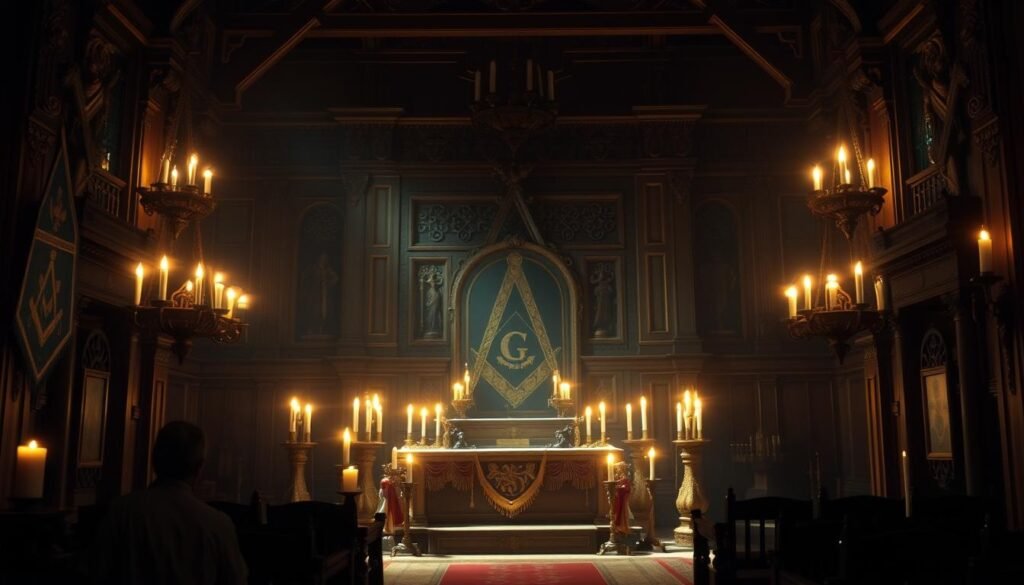
Looking into ritual and ceremony in Freemasonry helps us understand the fraternity’s values. It shows the importance of these practices in the Masonic tradition.
Famous Freemasons Throughout History
Famous freemasons have greatly influenced masonic history. Many notable masons have made significant contributions to society. This list includes revolutionary leaders, artists, and intellectuals.
George Washington, Theodore Roosevelt, and John Wayne are just a few examples. These individuals have shaped how people view freemasonry. The 33rd degree is given to about 100 masons in the U.S. each year. It honors their outstanding contributions.
Notable 33rd-degree masons include President Harry Truman and Businessman Henry Ford. Astronaut John Glenn Jr. is also on this list. Their lives show the values of freemasonry. They inspire others to follow their paths.
Revolutionary Leaders
Many revolutionary leaders, like George Washington and Benjamin Franklin, were freemasons. Their involvement shows freemasonry’s focus on community service and personal growth.
Artists and Intellectuals
Artists and intellectuals, such as J.S. Bach and John Wayne, were also freemasons. They used their talents to spread freemasonry’s values. They encouraged others to pursue their passions and make a difference.
Masonic Charitable Works and Community Impact
Freemasons have a long history of giving to charity and helping their communities. They have donated millions of dollars to different causes over the years. Their charity work includes supporting medical research, disaster relief, education, and community development.
The Masonic Charitable Foundation (MCF) is a great example of their philanthropy. It gives financial grants to Freemasons, their families, and the wider community. Freemasons also volunteer, helping out with food drives, charity events, and disaster relief.
Freemasons have a big impact on communities around the world. They give over 18.5 million hours of volunteer work every year. This shows their commitment to helping others and living by values like integrity and kindness.
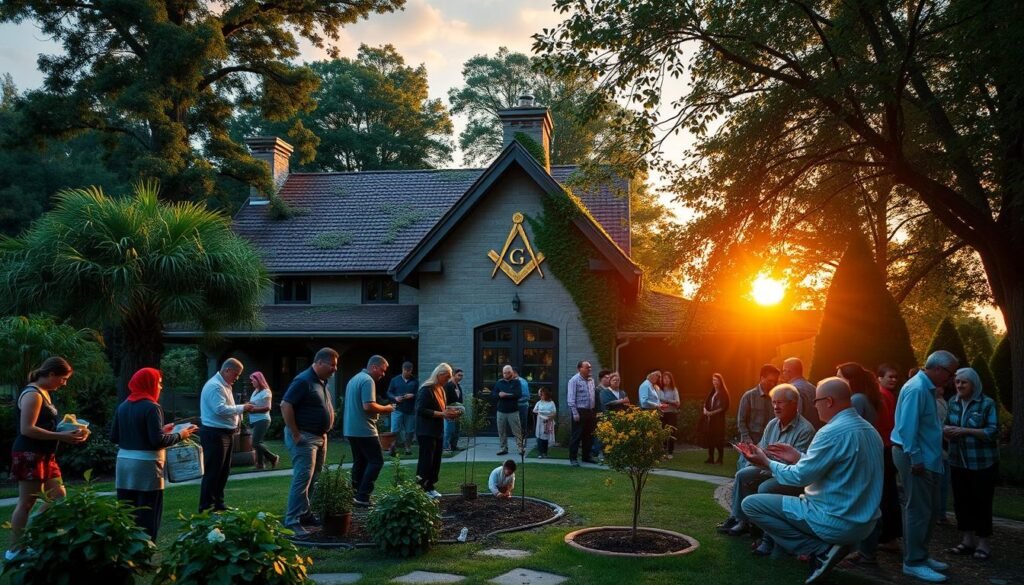
Freemasons show they care by supporting charities and doing community service. They want to make the world a better place. Through their charity and community work, they aim to help people and foster a sense of responsibility and civic engagement.
Debunking Common Myths About Freemasonry
Freemasonry has faced many masonic myths and freemasonry misconceptions over the years. These have led people to think it’s a secret society with bad intentions. But, looking into its history and values shows these myths are not true.
One big myth is that Freemasonry wants to control the world. But, it’s really a group focused on personal growth, friendship, and helping others. Its meetings and rituals are private, aiming to bring members together, not to hide secrets.
Some common masonic myths and freemasonry misconceptions include:
- The belief that Freemasonry is a secret society that seeks to control world events
- The idea that Freemasonry is a religion or a substitute for religion
- The notion that Freemasonry is a elitist organization that only accepts members from certain social classes
But, Freemasonry is really open to everyone, no matter their background or social status. It’s all about brotherly love, helping others, and truth, not about controlling others.
| Myth | Reality |
|---|---|
| Freemasonry is a secret society | Freemasonry is a private organization with public goals and principles |
| Freemasonry is a religion | Freemasonry is a fraternal organization that welcomes members of all faiths |
| Freemasonry is elitist | Freemasonry is a diverse organization that welcomes members from all walks of life |
By learning the truth about Freemasonry, we can fight against masonic myths and freemasonry misconceptions. This helps us see Freemasonry in a better light. It’s not a secret society, but a group with a long history and a strong commitment to helping others.
Conclusion: The Enduring Legacy of Freemasonry in Modern Society
Freemasonry’s history is rich and deep, showing its lasting impact on today’s world. The Grand Lodge of England started in 1717, marking the beginning of modern Freemasonry. It quickly spread to Europe and the New World, where it influenced America’s founders.
Now, Freemasonry is one of the oldest and largest fraternal groups, with millions of members. It focuses on personal growth, helping others, and community service. These values attract men who want to improve themselves and help others, showing the importance of unity and respect for all.
Freemasonry’s legacy is seen in its ongoing quest for knowledge and self-betterment. It also stands for justice, fairness, and doing what is right. In today’s complex world, Freemasonry’s adaptability and openness to change are key to building strong, lasting communities.
FAQ
What is Freemasonry?
Freemasonry is a group that started from medieval stonemason guilds in Europe. It teaches brotherly love, relief, and truth through rituals and teachings.
What is the history of Freemasonry?
Freemasonry began with medieval stone mason guilds. These guilds shared knowledge and promoted their trade. The first Grand Lodge was set up in London in 1717, marking a big change in Freemasonry.
What are the core principles and values of Freemasonry?
Freemasonry’s main values are brotherly love, relief, and truth. These values help Freemasons work together and support each other. They also focus on living morally and ethically.
How are Masonic lodges organized and structured?
Masonic lodges have a clear structure with different roles. There are Blue Lodges and other types, each with unique rituals. Freemasonry is global, with lodges in places like England and France.
What are the most significant Masonic symbols and their meanings?
The square and compass are key symbols, standing for morality and virtue. Freemasonry uses symbols like these to teach its lessons. These symbols are important in Masonic rituals and ceremonies.
What is the role of ritual and ceremony in Freemasonry?
Rituals and ceremonies are vital in Freemasonry. They teach moral lessons to members. These practices help Freemasons feel connected and share a common purpose.
What are some of the famous Freemasons throughout history?
Freemasonry has had many famous members, like George Washington and Benjamin Franklin. These individuals made big contributions in their fields and were part of the Masonic brotherhood.
What are the charitable works and community impact of Freemasonry?
Freemasonry is known for its charity and community work. It supports global initiatives, education, and local projects. Freemasons aim to positively impact the world through their efforts.
What are some common myths and misconceptions about Freemasonry?
Many myths surround Freemasonry, like it being a secret society. But these myths are not true. Freemasonry is a group that promotes moral behavior and is open to understanding.
Source Links
- https://www.thesquaremagazine.com/mag/article/045what-is-freemasonry-a-comprehensive-guide/
- https://www.lakeharrietlodge.org/ebooks-and-book-reviews
- https://www.history.com/news/freemasons-facts-symbols-handshake-meaning
- https://en.wikipedia.org/wiki/History_of_Freemasonry
- https://www.pennpress.org/9780812219883/the-origins-of-freemasonry/
- https://en.wikipedia.org/wiki/Freemasonry
- https://stjohns1.org/freemasonry/freemasonry-today/
- https://scottishritenmj.org/blog/history-modern-freemasonry
- https://www.infoplease.com/encyclopedia/life/social-orgs/private/freemasonry/organizational-structure
- https://freemason.org/masonic-ranks/
- https://oriental453.com/Main/structure-of-freemasonry/
- https://www.freemason.com/what-are-the-values-of-freemasonry/
- https://www.dummies.com/article/body-mind-spirit/religion-spirituality/freemasonry/the-basic-principles-of-freemasons-195589/
- https://www.ghlilley.com.au/blogs/news/freemason-symbols?srsltid=AfmBOopZgpBWzzPc6ttdd_QvO1EJePLa5GOC4QG1K8pzLoWgLm1lrmDh
- https://scottishritenmj.org/blog/masonic-symbolism
- https://en.wikipedia.org/wiki/Masonic_ritual_and_symbolism
- https://dallasfreemasonry.org/freemason-rituals
- https://freemason.org/famous-freemasons/
- https://www.ugle.org.uk/discover-freemasonry/famous-freemasons
- https://en.wikipedia.org/wiki/List_of_Freemasons_(A–D)
- https://masonicfind.com/how-do-freemasons-contribute-to-society
- https://www.thesquaremagazine.com/mag/article/045-giving-back-freemasonrys-commitment-to-charity/
- https://freemason.org/the_leader/september-2021-multiplying-our-impact/
- https://www.dummies.com/article/debunking-common-myths-about-freemasonry-200554
- https://web.cortland.edu/romeu/BeltonMythsDebunkedHeredom.pdf
- https://thecityvoice.org/2024/03/14/unveiling-the-enigma-freemasonry-the-new-world-order-and-the-illuminati/
- https://www.academia.edu/117747771/Freemasonry_Today_More_Relevant_Than_Ever
- https://www.thesquaremagazine.com/mag/article/2025q1freemasonrys-timeless-wisdom/
Click here to learn more about this topic in a related article.
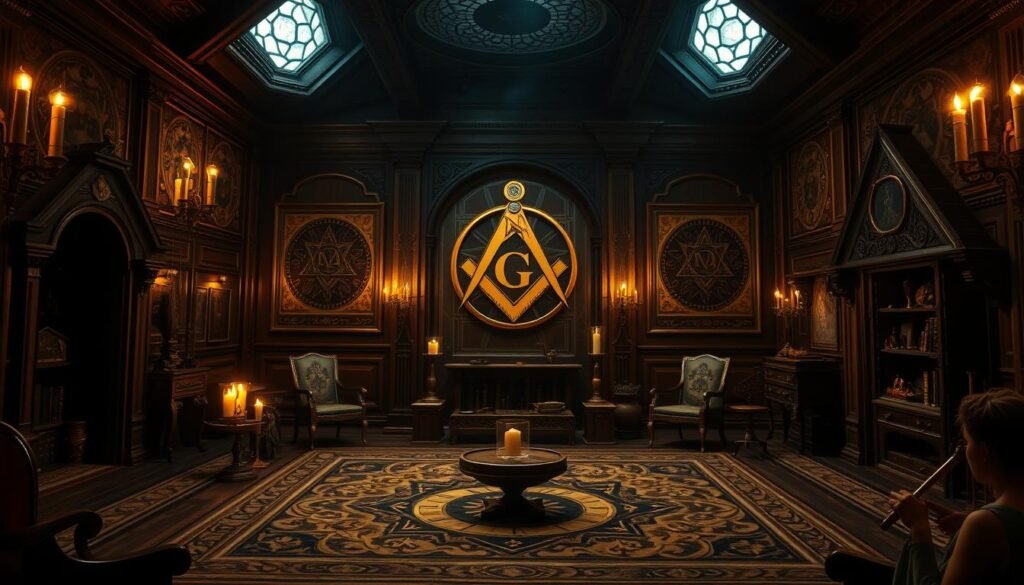

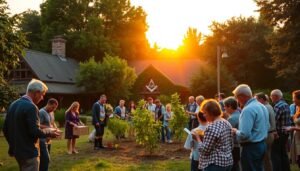


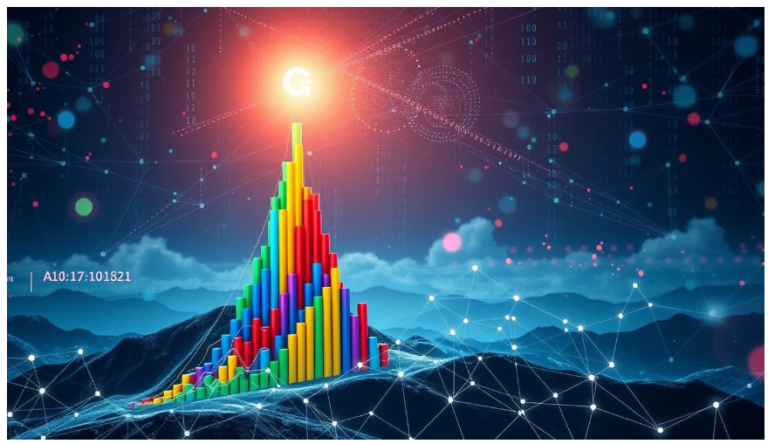
[…] Click here to learn more about this topic in a related article. […]